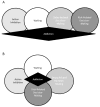Dissecting impulsivity and its relationships to drug addictions
- PMID: 24654857
- PMCID: PMC4360991
- DOI: 10.1111/nyas.12388
Dissecting impulsivity and its relationships to drug addictions
Abstract
Addictions are often characterized as forms of impulsive behavior. That said, it is often noted that impulsivity is a multidimensional construct, spanning several psychological domains. This review describes the relationship between varieties of impulsivity and addiction-related behaviors, the nature of the causal relationship between the two, and the underlying neurobiological mechanisms that promote impulsive behaviors. We conclude that the available data strongly support the notion that impulsivity is both a risk factor for, and a consequence of, drug and alcohol consumption. While the evidence indicating that subtypes of impulsive behavior are uniquely informative--either biologically or with respect to their relationships to addictions--is convincing, multiple lines of study link distinct subtypes of impulsivity to low dopamine D2 receptor function and perturbed serotonergic transmission, revealing shared mechanisms between the subtypes. Therefore, a common biological framework involving monoaminergic transmitters in key frontostriatal circuits may link multiple forms of impulsivity to drug self-administration and addiction-related behaviors. Further dissection of these relationships is needed before the next phase of genetic and genomic discovery will be able to reveal the biological sources of the vulnerability for addiction indexed by impulsivity.
Keywords: decision making; inhibition; vulnerability.
© 2014 New York Academy of Sciences.
Figures


References
-
- Evenden JL. Varieties of impulsivity. Psychopharmacology. 1999;146:348–361. - PubMed
-
- Fairbanks LA, et al. Adolescent impulsivity predicts adult dominance attainment in male vervet monkeys. American journal of primatology. 2004;64:1–17. - PubMed
-
- Hayaki J, Anderson BJ, Stein MD. Sexual risk-taking mediates the association between impulsivity and acquisition of sexually transmitted infections among hazardously drinking incarcerated women. The American journal on addictions/American Academy of Psychiatrists in Alcoholism and Addictions. 2012;21(Suppl 1):S63–71. - PMC - PubMed
Publication types
MeSH terms
Substances
Grants and funding
LinkOut - more resources
Full Text Sources
Other Literature Sources
Medical

